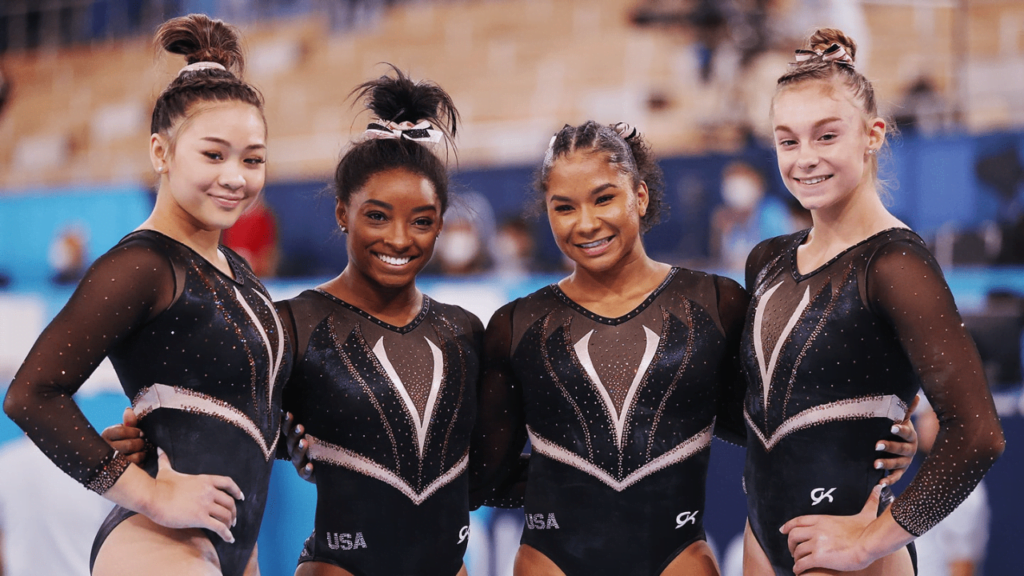The two-per-country rule in gymnastics, intended to promote diversity and prevent domination by powerhouse nations, has ignited considerable controversy at the 2024 Paris Olympics. Fans, athletes, and experts alike are questioning the fairness of this regulation.

The gymnastics community is once again abuzz with debate as the “two-per-country” rule leaves another talented athlete out of the running for the all-around finals at the Paris Olympics 2024. This time, the rule has sparked outrage among fans as Jordan Chiles narrowly misses the cut, despite proving to be one of the top gymnasts.
The Controversy at Paris 2024
At the Paris Olympics 2024, Team USA’s Simone Biles, Suni Lee, Jade Carey, Jordan Chiles, and Hezly Rivera showcased an outstanding performance in the gymnastics qualifying round, earning a score of 172.296.
Despite Biles tweaking her calf during warmups, she dominated the competition, finishing first with a score of 59.566, while Lee secured second place with 56.132 points, just edging out Chiles, who finished with 56.065 points. As a result, Chiles, who proved to be one of the best gymnasts in Paris, was excluded from the all-around finals due to the two-per-country rule, missing the cut by a mere 0.067 points.
The rule has ignited considerable controversy among fans and experts, who argue that it prevents the best gymnasts from competing for medals. Aly Raisman, a former Olympic gymnast, has been a vocal critic of the rule, stating that it is “the dumbest thing ever” and questioning why the best gymnasts shouldn’t compete, regardless of their country of origin. The rule’s critics argue that it undermines the spirit of competition by excluding top performers simply because they belong to a country with a deep pool of talent.
What is the Two-Per-Country Rule?
The two-per-country rule limits the number of gymnasts from any single country to two in each of the Olympic gymnastics finals, including the all-around and the individual apparatus finals. This rule was initially introduced to promote fairness and diversity, ensuring that no single country could dominate the medal standings by fielding an overwhelming number of competitors in the finals.
History and Rationale
The rule was first introduced after the 1972 Olympics, where countries like the Soviet Union and Japan had multiple gymnasts in the finals, leading to a near-monopoly in medal distribution.
In response, the International Olympic Committee (IOC) and the International Gymnastics Federation (FIG) limited countries to three gymnasts in the all-around final and two in the individual events starting from the 1976 Olympics. However, after Romania’s clean sweep of the all-around podium in the 2000 Olympics, the rule was further tightened to allow only two gymnasts per country in the all-around final as well.
The Rule’s Global Impact & Arguments
The two-per-country rule doesn’t just affect American gymnasts. At the Tokyo 2021 Olympics, Russia had three of the top six all-around qualifiers, but only two could advance to the finals. Similarly, China and Japan have also seen their gymnasts sidelined by this rule in various competitions over the years. This global impact has led many to question whether the rule, initially designed to ensure fairness, is now contributing to perceived unfairness by denying top athletes the chance to compete.
Proponents of the rule argue that it helps level the playing field and promotes global diversity in gymnastics. By limiting the number of competitors from powerhouse countries, the rule gives gymnasts from smaller or less dominant countries a fairer chance to reach the finals and potentially win medals. This inclusivity aims to foster the growth of gymnastics worldwide, encouraging participation and competition from a broader range of countries.
Potential Solutions and Alternatives
Given the ongoing debate, some have suggested potential modifications to the rule. One proposal is to allow the top-scoring gymnasts to advance regardless of their nationality, ensuring that the best athletes compete in the finals. Another suggestion is to increase the number of finalists, allowing more gymnasts from powerhouse countries while still maintaining a diverse field.
These alternatives aim to strike a balance between promoting fairness and ensuring that the best competitors have a chance to showcase their skills on the world stage.
In a Nutshell!
The two-per-country rule in Olympic gymnastics remains a contentious issue. While it was introduced with the noble intention of promoting fairness and diversity, its application has often resulted in top gymnasts being excluded from the finals. As the Paris 2024 Olympics have shown, the rule can leave some of the world’s best athletes, like Jordan Chiles, on the sidelines, sparking debate and frustration among fans and experts alike.
Whether the rule will be modified or replaced in the future remains to be seen, but the conversation about how to best achieve fairness in Olympic gymnastics is far from over.
Read Next:

The Psychology of Love: Why Valentines Day Matters More Epic Than You Think
Discover the psychology of love and why Valentines Day is more important than you think. Learn how love impacts the brain, strengthens relationships, and boosts

Premier League Highlights: Arsenal Humiliate Man City 5-1, Spurs and Palace Secure Crucial Wins
Arsenal demolished Manchester City 5-1 in a statement premier league highlights win, reigniting their title hopes. Meanwhile, Crystal Palace stunned Man United 2-0, and Tottenham

How Budget 2025 Impacts the Indian Middle-Class: Major Tax Benefits and Glaring Omissions
Budget 2025 offers major tax relief to the middle class, including zero tax on incomes up to ₹12 lakh. However, it misses out on incentives

Degrees vs Employability: Why “Highly Qualified Degree Holders” Struggle to Find Jobs While “Less Qualified Individuals” Get Hired Faster!
Many highly qualified individuals struggle to secure jobs, while less qualified candidates get hired quickly. This Degrees vs Employability paradox is caused by employer preferences,
